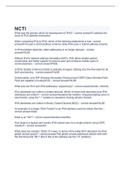Exam (elaborations)
NCTI 2023 with verified questions and answers
- Course
- Institution
Question Answer What was the primary driver for development of IPv6? To address the issue of IPv4 address exhaustion. When comparing IPv4 to IPv6, which of the following statements is true IPv4 uses a 32-bit address scheme, while IPv6 uses a 128-bit address scheme. In IPv6-e...
[Show more]



